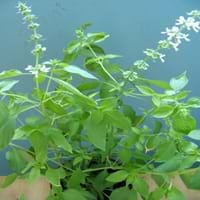Life Span
Perennial
Perennial
Origin
Europe, Asia
Not Available
Types
Not Available
Not available
Habitat
Dry areas, Roadsides, stream banks, Stream side, Waste areas
Not Available
USDA Hardiness Zone
3-7
9-11
Sunset Zone
1a, 1b, 2a, 2b, 3a, 3b, 4, 5, 6, 7, 8, 9, 10, 11, 12, 13, 14, 15, 16, 17, 18, 19, 20, 21, 22, 23, 24
A1, A2, A3, H1, H2, 1a, 1b, 2a, 2b, 3a, 3b, 4, 5, 6, 7, 8, 9, 10, 11, 12, 13, 14, 15, 16, 17, 18, 19, 20, 21, 22, 23, 24
Habit
Clump-Forming
Clump-Forming
Flower Color
White, Lavender
White
Flower Color Modifier
Bicolor
Bicolor
Fruit Color
Sandy Brown
Tan
Leaf Color in Spring
Gray Green, Gray
Green, Gray Green
Leaf Color in Summer
Gray Green, Gray
Green, Gray Green
Leaf Color in Fall
Gray Green, Gray
Green, Gray Green
Leaf Color in Winter
Light Green
Light Green
Leaf Shape
Arrowhead
Oval
Plant Season
Spring, Summer, Fall
Spring, Summer, Fall, Winter
Sunlight
Full Sun, Partial Sun
Full Sun, Partial Sun
Type of Soil
Clay, Loam, Sand
Loam, Sand
The pH of Soil
Acidic, Neutral, Alkaline
Neutral
Soil Drainage
Well drained
Well drained
Bloom Time
Summer, Late Summer, Early Fall
Indeterminate
Tolerances
Drought, Dry soil
Drought
Where to Plant?
Container, Ground
Container, Ground, Pot
How to Plant?
Seedlings
Cuttings, Seedlings
Plant Maintenance
Low
Medium
Watering Requirements
Do Not over Water, Never Over-water, Requires regular watering, Water when soil is dry
Allow soil to be completely dry in between waterings, Do Not over Water, Requires regular watering
In Summer
Lots of watering
Lots of watering
In Spring
Moderate
Moderate
In Winter
Average Water
Average Water
Soil pH
Acidic, Neutral, Alkaline
Neutral
Soil Type
Clay, Loam, Sand
Loam, Sand
Soil Drainage Capacity
Well drained
Well drained
Sun Exposure
Full Sun, Partial Sun
Full Sun, Partial Sun
Pruning
Prune if you want to improve plant shape, Prune in spring, Remove damaged leaves, Remove dead leaves
Remove damaged leaves, Remove dead branches, Remove dead leaves
Fertilizers
fertilize every 2-3 weeks while growing, fertilize in growing season
All-Purpose Liquid Fertilizer
Pests and Diseases
Caterpillars, Leaf Hoppers, Nematodes, Spider mites
Downy mildew, Dry root rot, Fusarium wilt, Gray mold, Japanese Beetles
Plant Tolerance
Drought, Frost
Drought
Flower Petal Number
Single
Single
Fragrant Bark/Stem
Yes
Yes
Foliage Texture
Medium
Medium
Foliage Sheen
Matte
Matte
Attracts
Flying insects, Insects, Spider Mites
Aphids, Beetles, Leaf Hoppers, Nematodes
Allergy
Avoid during Pregnancy, Headache, Stomach pain, Vomiting
Hives, Itchiness, Rash, Swelling
Aesthetic Uses
Beautification, Landscape Designing, Showy Purposes
Borders, Used for decorating walls, fences, gates, hedges, etc.
Beauty Benefits
Not Available
Not Available
Environmental Uses
Air purification
Air purification
Medicinal Uses
Arthritis, Cold, constipation, Fever, Insomia, Migraines, Upset stomach
Low calories, Manganese, Potassium, ß-carotene, Vitamin A, Vitamin K
Part of Plant Used
Whole plant
Leaf Stalks, Leaves
Other Uses
Air freshner, Decoration Purposes, Employed in herbal medicine, Making Perfumes, Making Shampoo, Making Sweet Scented Oil, Medicinal oil, Used as Ornamental plant, Used for its medicinal properties
Added to salads, Powdered and mixed with tea, Used in tea, wine and sweet dishes, Used to flavour soups
Used As Indoor Plant
Yes
Yes
Used As Outdoor Plant
Yes
Yes
Garden Design
Container, Herb / Vegetable, Mixed Border
Container, Edible, Herb / Vegetable, Mixed Border
Botanical Name
NEPETA cataria
OCIMUM x citriodorum
Common Name
Cat Nip, Catnip
Lemon Basil
In Hindi
कटनीप
नींबू तुलसी
In German
Katzenminze
Limonenbasilikum
In French
cataire
citron basilic
In Spanish
Catnip
Ocimum × citriodorum
In Greek
Είδος δυόσμου
λεμόνι βασιλικός
In Portuguese
catnip
manjericão limão
In Polish
Kocimiętka
Bazylia cytrynowa
In Latin
catnip
lemon Basilius
Phylum
Magnoliophyta
Tracheophyta
Class
Magnoliopsida
Magnoliopsida
Family
Lamiaceae
Lamiaceae
Clade
Angiosperms, Asterids, Eudicots
Asterids
Tribe
Mentheae
Not Available
Subfamily
Nepetoideae
Not Available
Number of Species
Not Available
Season and Care of Catnip and Lemon Basil
Season and care of Catnip and Lemon Basil is important to know. While considering everything about Catnip and Lemon Basil Care, growing season is an essential factor. Catnip season is Spring, Summer and Fall and Lemon Basil season is Spring, Summer and Fall. The type of soil for Catnip is Clay, Loam, Sand and for Lemon Basil is Loam, Sand while the PH of soil for Catnip is Acidic, Neutral, Alkaline and for Lemon Basil is Neutral.
Catnip and Lemon Basil Physical Information
Catnip and Lemon Basil physical information is very important for comparison. Catnip height is 980.00 cm and width 60.00 cm whereas Lemon Basil height is 30.50 cm and width 30.50 cm. The color specification of Catnip and Lemon Basil are as follows:
Catnip flower color: White and Lavender
Catnip leaf color: Gray Green and Gray
Lemon Basil flower color: White
- Lemon Basil leaf color: Green and Gray Green
Care of Catnip and Lemon Basil
Care of Catnip and Lemon Basil include pruning, fertilizers, watering etc. Catnip pruning is done Prune if you want to improve plant shape, Prune in spring, Remove damaged leaves and Remove dead leaves and Lemon Basil pruning is done Remove damaged leaves, Remove dead branches and Remove dead leaves. In summer Catnip needs Lots of watering and in winter, it needs Average Water. Whereas, in summer Lemon Basil needs Lots of watering and in winter, it needs Average Water.





